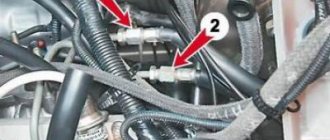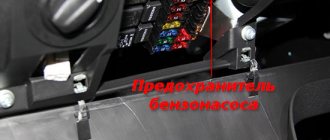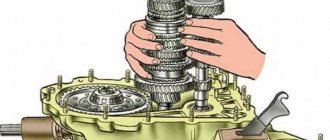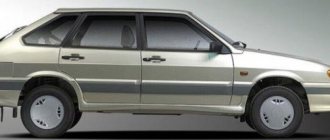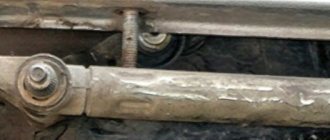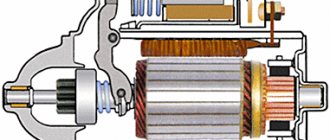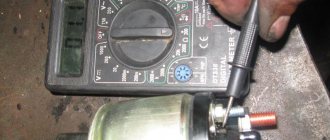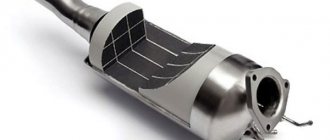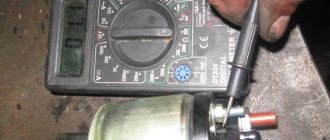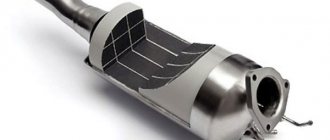The VAZ 2114 has an injection engine with a volume of 1.5 and 1.6 liters. Such engines are equipped with a large number of sensors, as well as electronic fuel supply under pressure. Quite often it happens that a breakdown occurs in a car and fuel stops flowing to the engine, thereby preventing it from starting. It is quite difficult to find the cause of a fuel pump failure on your own, but after studying our article, you can easily determine the culprit of the breakdown and solve the problem as soon as possible.
In this article we will talk about the breakdown of the fuel pump on a VAZ 2114, namely why this part stopped pumping fuel.
Design and principle of operation of the fuel pump
In order to find the cause of the breakdown, you must first know the design and operating principle of the fuel pump.
Design
The gasoline pump is made of many parts and resembles an electric DC motor. Its body is made of plastic and metal; inside the body there is a magnet and a rotor, on the shaft of which an impeller is mounted on one side, and a current collector on the other. The fuel pump itself is a brushed motor, which greatly reduces its reliability; many modern cars (foreign cars) have already switched to brushless electric pumps.
One of the important elements of the pump is the check valve, which maintains the built-up pressure in the system and does not allow it to flow back into the tank through the valve.
Principle of operation
When voltage appears on the fuel pump block, it begins to rotate, the impeller pumps fuel into the system, as soon as it reaches the required amount, the fuel pump valve closes, thereby closing the path to the outflow of fuel back into the tank. After which you can start the engine. You can clearly hear the operation of the fuel pump by turning on the ignition and listening to its operation. The fuel pump will make a characteristic squeak and stop after a few seconds - this will mean that the pressure has been pumped into the system.
Service
In order for the gas pump to serve for a long time, it is important to know how to operate it correctly. The first thing you need to pay attention to is the quality of the fuel that the driver fills his car with. Gasoline for the pump acts as a lubricant, and poor quality will only accelerate valve wear. Dirty gasoline has a detrimental effect on the operation of the pump, as its small particles clog the insides. Therefore, coarse and fine filters need to be changed every 30 thousand kilometers. The cleaners themselves should be purchased only from trusted manufacturers. This is especially true for electric fuel pumps.
They are more “capricious” regarding the quality of fuel and its filtration. If we talk about mechanical pumps, then you can put a fine filter for injection engines in front of it. Such elements clean fuel better and are less likely to become clogged. Also in mechanical pumps, it is important to monitor the condition of the adjusting gasket, which is located between the roller and the balancer. Over time, the part wears out and the gap between it and the drive roller becomes larger. If it becomes higher than the permissible 1.3 mm, then the roller will not fully press the balancer. As a result, the device will not be able to create the required pressure in the line. After installing a new fuel pump, you should adjust it correctly so that the drive shaft protrudes about 2-3 mm from the lower pump housing.
Fuel pump system
The fuel pump itself does not work; it is part of a special station, the so-called “fuel pump cup”. This part is a bracket for mounting the fuel pump in the tank. Also, a special coarse fuel filter is put on the fuel pump, which allows you to keep the fuel pump from dirt getting into it. A fuel level sensor and a fuel pressure regulator are installed on the glass. Together, all these parts form the fuel pump station, or popularly the “glass”.
Main advantages
Engineers decided to improve the engine, so the injection circuit became popular in VAZ 2110 cars. In this case, the fuel mixture enters under pressure directly into the combustion chamber from the injectors.
The injector has gained a huge advantage over a carburetor engine, and, despite the fact that its cost is much higher, the use of carburetor systems is practically no longer practiced anywhere. After all, all information about the engine is collected by a computer, so it becomes possible to accurately dose the amount of fuel in all engine operating modes. Due to this, you can significantly reduce fuel consumption and use fuel pump resources more efficiently.
Cold start and warm-up
The injector operates differently depending on the air and engine temperature. In any case, the fuel pump system precisely doses the fuel supply to the injectors, due to which you can quickly reach the required idle speed.
Symptoms of a problem
There are many signs of a fuel pump malfunction and they are all similar to each other, and they can also be confused with breakdowns in other elements of the fuel system, such as injectors, filters, RTDs, etc. Signs of malfunction in fuel system elements are always similar, but the fuel pump has its own factor that can clearly indicate its malfunction - the sound of its operation.
Any pump, even the highest quality and new, should make a sound when operating. If there is no sound, then something is definitely wrong with the pump.
Possible symptoms of failure:
- Loss of vehicle dynamics;
- Difficulty starting the engine (the starter turns for a long time);
- The car stalls when you press the gas pedal;
All these problems can be caused by other fuel cells. For example, clogged injectors can also affect poor starting and loss of vehicle dynamics.
see also
Gasoline pump
- 0 0 30k
Fuel pump circuit: mechanical, electrical
- 23 6 70k
The causes of fuel pump failure are not always the same, and the devices themselves can be electrical or mechanical. Diagnostics of the performance of these types has differences, so we will consider ways to check the operation of gasoline pumps separately. However, the operation of the fuel pump can be checked in a maximum of 7 stages.
The need to check the fuel pump appears when the following signs of malfunction occur:
- the engine stalled;
- the car moves unevenly, jerkily;
- the engine idles unstable and does not start;
- there are “floating” speeds;
- increasing noise, whistling when the car is moving.
Checking the fuel pump
To check the fuel pump, you need to measure the fuel pressure in the fuel rail and check the pump itself for pressure “into the wall”.
To check the fuel pressure, you need a special device, a fuel pressure gauge; you can also use a regular pressure gauge with a hose, connecting it to the ramp through clamps.
- On a car with a 1.5-liter engine, the pressure in the fuel rail should be: 2.7-3.4 bar;
- On a car with a 1.6-liter engine, the pressure in the fuel rail should be: 3.5-4.0 bar;
Then the pressure of the fuel pump is checked, which it presses into the wall; for this it must be dismantled (on 1.5-liter engines you can simply clamp the return line). In this way, the power of the pump is checked when checking the pressure “into the wall”; a good pump presses pressure up to 8 bar.
Pinout BN VAZ 2113, 2114, 2115
— block headlights; — gearmotors for headlight cleaners*; - fog lights*; — ambient temperature sensor; - sound signals; — engine compartment lamp switch; — electric motor of the engine cooling system fan; — generator; — low oil level indicator sensor; — washer fluid level sensor; — front brake pad wear sensor; — wire tips connected to the common windshield washer pump**; — windshield washer pump; — headlight washer pump*; — wire ends for connecting to the rear window washer pump on VAZ-2113 and VAZ-2114 cars; — low oil pressure indicator sensor; — engine compartment lighting lamp; — wire lug for connecting to the wiring harness of the engine control system; — gear motor for windshield wiper; — starter; — a block connected to the wiring harness of the ignition system on carburetor cars; — coolant temperature indicator sensor; — reversing light switch; — low brake fluid level indicator sensor; - accumulator battery; — low coolant level indicator sensor; — relay for turning on fog lights; - mounting block; — brake light switch; — plug socket for a portable lamp; — hydrocorrector scale illumination lamp; — switch for the parking brake indicator lamp; — block for connecting a backlight lamp; — switch for instrument lighting lamps; - Understeering's shifter; - hazard warning switch; — front seat heating element relay; — ignition switch; — rear fog light circuit fuse; - fuse for the front seat heating elements; — door lock circuit fuse; — front ashtray illumination lamp; — ignition relay; - cigarette lighter; — glove box lighting lamp; — switch for the glove compartment lighting lamp; — heater fan electric motor; — additional resistor for the heater electric motor; — heater fan switch; - heater switch illumination lamp; — lamp for illuminating the heater levers; — gear motors for electric windows of the front doors; — power window switch for the right front door (located in the right door); — gear motors for locking front door locks; — wires for connecting to the right front speaker; — gearmotors for locking rear doors; — wires for connecting to the right rear speaker; — door lock control unit; — wires for connection to radio equipment; — headlight cleaner switch*; — rear window heating element switch; — relay for turning on the rear fog lights; — block for connection to the heating element of the right front seat; — rear fog light switch; — switch for the heating element of the right front seat; — fog light switch*; — switch for external lighting lamps; — left front seat heating element switch; — block for connection to the heating element of the left front seat; — wires for connecting to the left front speaker; — power window switch for the left front door (located in the left door); — power window switch for the right front door (located in the left door); — wires for connecting to the left rear speaker; — side direction indicators; — courtesy light switches on the front door pillars; — courtesy light switches on the rear door pillars; - lampshade; — ceiling lamp for individual interior lighting; — block for connecting to the wiring harness of the electric fuel pump; — trunk light switch; — instrument cluster; — trunk lighting lamp; — display unit of the on-board control system; - trip computer*; — block for connecting the wiring harness of the engine control system; — rear exterior lights; — rear interior lights; — pads for connecting to the rear window heating element; — license plate lights; — additional brake signal located on the spoiler. Do you like cartoons and sex between family members? Then you will surely enjoy our site. We constantly post incest-themed cartoons. Lovers of high-quality animation and family sex are welcome! You will definitely like it here, you can be sure of that.
Why doesn't the fuel pump pump?
If the fuel pump has stopped pumping fuel pressure, then starting the car is out of the question.
Possible reasons:
- The fuel pump fuse has blown;
- The fuel pump relay burned out;
- The fuel pump burned out;
These three reasons are the main reasons why the fuel pump on a VAZ 2114 stops pumping fuel.
Finding the reason
The first thing you need to do is make sure there is voltage at the fuel pump, and it can go out for several reasons: a blown fuse or relay, burnt-out wiring.
Inspect the fuel pump fuse for integrity. It is located under the center console at the feet of the front passenger. It is necessary to remove the decorative cover of the leg air duct; there you can find three fuses and three relays. All of them must be intact.
You can check the relay using a multimeter by setting the switch to continuity, connect the probes to the relay coil, it should show some resistance. If the multimeter shows an open circuit, then the relay is faulty and requires replacement.
If the whole thing is most likely burned out, the fuel pump must be dismantled to do this.
Motor
Fuel pump motor VAZ 2114
We checked the pressure and wiring, everything works like clockwork, but the engine stalls. The fuel pump may not pump due to a breakdown of the motor - the main element that drives fuel. We check its functionality with the same light bulb: attach its wires to any terminal of the motor, turn the ignition. The lamp blinked - it was time to throw out the motor. And again, run to the store for a brand new motor.
The terminals may oxidize and not make contact, as a result of which the fuel pump will not pump. The motor in this case may be normal. And the terminals just need cleaning (possibly re-soldering). There is an opinion that the terminals are oxidized due to low-quality fuel (the octane number does not match the declared one).
